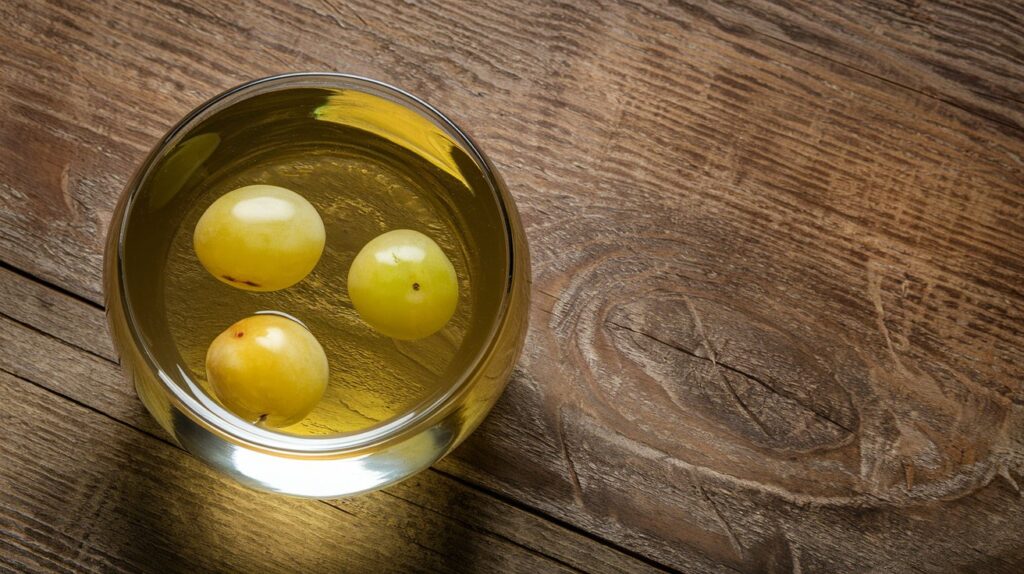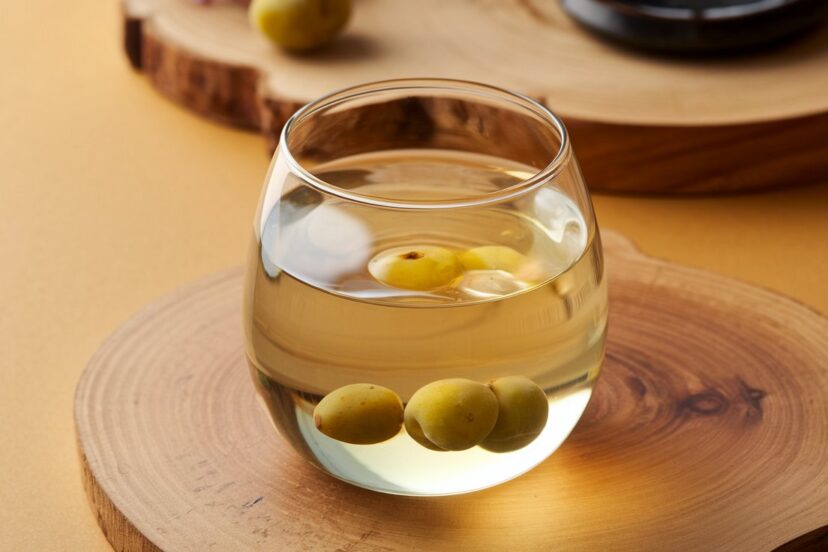Japanese Plum Wine: A Cultural Treasure
Post Disclaimer
*We may earn a commission for purchases made using our links. Please see our disclosure to learn more.
The first time I tasted umeshu was in a tiny neighborhood bar in Tokyo. The bartender, noticing my indecision, suggested this amber-colored liqueur with a knowing smile. “Very Japanese,” he said, pouring the sweet, tangy liquid over ice. That initial sip, balancing fruity sweetness with complex tartness, was my introduction to one of Japan’s most beloved traditional drinks.
Japanese plum wine, or umeshu (梅酒), stands as a testament to Japan’s gift for transforming simple ingredients into something extraordinary. Made by steeping unripe ume fruits in alcohol with sugar, this sweet liqueur represents centuries of tradition while continuing to find new admirers in the modern world.
Key Takeaways:
- Japanese plum wine (umeshu) is a traditional fruit liqueur made by steeping green ume plums in shochu or other spirits with sugar.
- Despite its name, ume is actually closer botanically to apricots than plums.
- Umeshu typically contains 10-15% alcohol content and can be enjoyed in various ways—chilled, on the rocks, with hot water, or in cocktails.
- While commercial brands are widely available, homemade umeshu remains popular in Japan, with many families following recipes passed down through generations.
- The taste profile combines sweetness with distinctive sour notes and almond-like complexity from the plum stones.
Japanese Plum Wine
Choya Umeshu with Ume
Experience the rich, authentic taste of Choya Umeshu, Japan’s #1 plum wine. Made with hand-picked ume plums, this premium umeshu offers a perfect balance of sweetness and gentle tartness, with subtle almond notes from the fruit’s pit. Crafted in Osaka, Japan, this imported non-vintage umeshu is best enjoyed chilled, on the rocks, or mixed into cocktails for a refreshing twist.
- Authentic Taste: Made with real ume plums for a rich, traditional flavor.
- Versatile Serving Options: Enjoy it chilled, on the rocks, or in cocktails.
- Premium Quality: Japan’s #1 umeshu brand, crafted with expertise.
- Sweet Profile: May be too sweet for those who prefer drier wines.
- Alcohol Content: Slightly lower than standard wines, which may not suit all preferences.
- Limited Availability: Imported, so availability may vary by region.
Choya Umeshu with Ume is a premium Japanese plum wine crafted with whole ume plums, delivering a naturally sweet, tangy, and slightly nutty flavor. Imported from Osaka, Japan, this umeshu is known for its smooth, well-balanced taste with subtle almond notes from the fruit’s pit. As Japan’s #1 umeshu brand, Choya is celebrated for its high-quality ingredients and traditional brewing methods. Enjoy it chilled, on the rocks, or as a cocktail base for a refreshing and flavorful experience.
Choya Umeshu Non-Alcoholic Plum-Wine Soda (Pack of 6)
Enjoy the sweet and tangy flavors of traditional umeshu without the alcohol with Choya Umeshu Non-Alcoholic Plum-Wine Soda. This carbonated Japanese plum drink captures the rich, fruity taste of ume plums with a light, bubbly texture, making it a refreshing and guilt-free alternative to traditional plum wine. Perfect for any occasion, this ready-to-drink soda can be enjoyed chilled on its own or as a mixer for creative mocktails.
- Authentic Plum Flavor: Captures the taste of umeshu without alcohol.
- Light & Refreshing: Perfect balance of sweetness, tartness, and fizz.
- Convenient Packaging: Ready-to-drink 350ml cans, great for on the go.
- Sweetness Level: May be too sweet for those who prefer drier drinks.
- Not a Wine Substitute: Lacks the depth of traditional umeshu.
- Pricey for a Soda: More expensive than regular soft drinks.
Choya Umeshu Non-Alcoholic Plum-Wine Soda offers the authentic sweet and tangy taste of ume plums in a light, fizzy, and alcohol-free beverage. Crafted by Japan’s top umeshu brand, this refreshing soda delivers the rich fruitiness of traditional plum wine without the alcohol, making it a great alternative for all ages. Enjoy it chilled straight from the can or as a mixer for unique mocktails.
Origins and History
The history of umeshu is intertwined with Japan’s relationship to the ume fruit itself. Introduced from China over a millennium ago, ume quickly became integrated into Japanese culture. Initially valued for medicinal properties, ume fruits were used to treat fatigue, improve digestion, and prevent illness.
The practice of preserving ume in alcohol emerged during the Edo period (1603-1868). What began as a medicinal tonic gradually evolved into a beloved household beverage. Traditionally, families would prepare their annual batch when green ume appeared in late spring, allowing it to mature for consumption throughout the year.
This preservation method reflects the Japanese cultural value of capturing seasonal bounty. In a society deeply attuned to seasonal changes, umeshu became a way to transform spring’s ephemeral gifts into something that could be enjoyed during colder months when its warming properties were most appreciated.
The Ume Fruit: Not Quite a Plum
Despite being commonly translated as “plum wine,” umeshu contains no actual plums. The ume fruit (Prunus mume) is botanically closer to apricots than plums, which explains its unique flavor profile that sets umeshu apart from other fruit liqueurs.
The ume harvest is brief but culturally significant, typically occurring from late May to early June. The fruits are harvested while still firm and green, deliberately before ripening. At this stage, they possess the perfect balance of acidity and compounds that will develop into umeshu’s characteristic flavor.
In Japanese markets during ume season, you’ll find these small, hard fruits with their distinctive slightly fuzzy skin. Their flesh is firm and extremely sour when raw, making them unsuitable for fresh eating but ideal for preservation methods like umeshu-making and pickling (umeboshi).
Traditional Production Method
The beauty of umeshu lies in its simplicity. The traditional production method requires just three ingredients, ume fruits, sugar, and alcohol, combined with the essential ingredient of time.
The basic process follows these steps:
- Fresh green ume fruits are carefully washed and dried completely.
- The stem end of each fruit is removed, often using a toothpick to extract the small stem remnant.
- The fruits are layered in a large glass jar with rock sugar (or sometimes honey).
- A neutral spirit, traditionally shochu, is poured over the mixture until everything is submerged.
- The jar is sealed and stored in a cool, dark place.
- The mixture steeps for at least three months, though six months to a year yields superior results.
During this steeping period, a remarkable transformation occurs. The alcohol draws out the essence of the ume, the fruit gradually changes from green to pale yellow, and the liquid transforms from clear to amber. The plum stones release an almond-like essence due to their small amount of amygdalin, adding another dimension to the final product.
Regional Variations and Commercial Production
Like many traditional Japanese foods and drinks, umeshu displays regional character across Japan. Wakayama Prefecture, which produces about 60% of Japan’s ume crop, creates umeshu that prominently features their prized local fruit. In Okinawa, varieties made with awamori (the local distilled spirit) offer a distinct, robust character.
Commercial production has made umeshu widely available beyond homemade versions. Major producers like Choya and Takara have standardized and popularized umeshu nationally and internationally. These companies have also innovated within the category, offering versions with different sweetness levels, aging techniques, or additional flavorings.
Premium commercial umeshu often contains whole fruits in the bottle, a visual reminder of its traditional production method. Some specialty producers age their umeshu in wooden barrels, creating deeper, more complex flavors that can rival fine whiskeys or brandies in sophistication.
The Cultural Significance of Umeshu
Umeshu transcends its identity as merely a beverage to become a cultural touchstone in Japanese society. The annual ritual of making homemade umeshu coincides with the rainy season and marks the transition from spring to summer. Families gather to prepare their batch, often marking the jars with the date, to be opened at special occasions throughout the year.
This liqueur embodies several Japanese cultural values. It represents the concept of “mottainai” (もったいない), the sense that nothing should be wasted, as the spent fruits are often repurposed after the liqueur is ready. It also demonstrates the Japanese appreciation for transformation over time and the beauty found in patient craftsmanship.
In Japanese hospitality, offering umeshu to guests carries special significance. It represents sharing something carefully crafted and patiently awaited. A host serving homemade umeshu is offering not just a drink but a story, of when it was made, the quality of that year’s ume harvest, or the special occasion for which it had been saved.
Modern Appreciation and Serving Styles

Today, umeshu enjoys popularity both in traditional settings and contemporary cocktail culture. Its versatility allows for multiple serving styles, each highlighting different aspects of its character:
- Straight and chilled (reishu): The purest expression of umeshu’s complexity.
- On the rocks (rokku): The slight dilution opens up different flavor notes.
- With hot water (oyuwari): A comforting winter drink that highlights umeshu’s medicinal heritage.
- With soda water (sodawari): A refreshing summer option that tempers the sweetness.
- In cocktails: Mixed with everything from gin to champagne in creative bar programs.
In recent years, umeshu has gained international appreciation. Craft cocktail bars from New York to London now stock premium umeshu brands, and bartenders value its unique sweet-sour profile for creating balanced drinks. This global recognition has introduced new audiences to this traditional Japanese liqueur while encouraging innovation in its presentation and use.
Health Aspects and Nutrition
Traditional Japanese wisdom attributes numerous health benefits to umeshu japanese plum wine, some of which are supported by modern research. The ume fruit contains organic acids, minerals, and polyphenols that offer potential antioxidant benefits. Throughout history, umeshu has been used as a home remedy for fatigue, improving digestion, and enhancing circulation.
However, it’s important to note that umeshu is still an alcoholic beverage, typically containing 10-15% alcohol by volume, and also contains significant sugar. Moderation is key to enjoying any potential benefits without overdoing the alcohol or sugar intake.
What’s particularly interesting is how umeshu exemplifies the Japanese approach to functional food—items consumed not just for pleasure but for specific health purposes. Many Japanese people still take a small glass of umeshu for a sore throat or to ward off colds during winter months, continuing traditions that date back centuries.
Making Your Own Umeshu
Creating homemade umeshu japanese plum wine connects practitioners to a centuries-old tradition. While finding fresh green ume outside Japan can be challenging, Asian markets sometimes carry them frozen or preserved specifically for umeshu-making. The process requires minimal ingredients and equipment but maximal patience.
A basic recipe typically includes:
- 1 kg green ume fruits
- 500-800 g rock sugar (adjustable based on preferred sweetness)
- 1.8 L white liquor or shochu (35-40% alcohol)
- A large glass jar with a sealed lid
The beauty of homemade umeshu is that it can be customized to personal preference, adjusting the sugar level, experimenting with honey instead of rock sugar, or adding complementary flavors like cinnamon or vanilla. The essential element is patience, good umeshu cannot be rushed and requires at least several months of steeping.
Making umeshu at home creates a connection to Japanese cultural rhythms even from afar. The anticipation as it steeps, the periodic gentle turning of the jar, and finally the decanting ceremony all become mindful practices that contrast with our often hurried modern lives.
Pairing Umeshu with Food
Umeshu’s complex flavor profile makes it an excellent companion to various foods. Its sweet-tart character works particularly well with:
- Rich, fatty dishes where its acidity cuts through heaviness
- Spicy foods, as its sweetness tempers heat
- Desserts, especially those featuring stone fruits or almonds
- Cheese plates, particularly with aged cheeses
- Traditional Japanese wagashi sweets, creating an interesting contrast
In Japanese cuisine, umeshu japanese plum wine is often served as an aperitif before meals or as a digestif afterward. Its versatility allows it to complement the full range of a meal experience, from stimulating appetite to aiding digestion.
The temperature at which umeshu is served significantly affects its pairing potential. Chilled umeshu works beautifully with summer dishes and lighter fare, while room temperature or warm umeshu complements heartier winter foods and can even accompany hot pot dishes.
Umeshu in Popular Culture
Umeshu makes frequent appearances in Japanese literature, film, and television, often symbolizing tradition, domesticity, or the passing of seasons. In novels and memoirs about Japanese life, the making of umeshu frequently appears as a ritual that marks time and connects generations.
In contemporary popular culture, umeshu has experienced renewed interest among younger generations as part of a broader appreciation for traditional crafts and foods. Social media has played a role in this revival, with homemade umeshu recipes and beautiful photographs of the steeping process gaining popularity online.
This cultural presence extends beyond Japan as umeshu appears in international cooking shows, travel documentaries, and lifestyle publications. Its photogenic quality—amber liquid with floating fruits—makes it visually appealing for modern media, while its story provides rich cultural context.
Conclusion
Japanese plum wine represents far more than just another alcoholic beverage. It embodies Japanese cultural values of seasonal awareness, patience, transformation, and the appreciation of subtle flavors. Each glass of umeshu contains not just alcohol, sugar, and fruit, but time, tradition, and craftsmanship.
As I’ve deepened my appreciation for umeshu over the years, I’ve come to see it as a liquid embodiment of Japanese aesthetic principles, finding beauty in simplicity, respecting natural processes, and acknowledging the poignancy of time’s passage. The annual cycle of umeshu production mirrors life itself: the anticipation of spring’s harvest, the patience of summer’s steeping, and the reward of autumn and winter’s enjoyment.
For those new to this remarkable liqueur, I encourage exploration, try different serving styles, compare various commercial brands, and perhaps even attempt making your own batch. Like me, you might find that umeshu offers not just a pleasant drinking experience but a window into Japanese cultural values and a more mindful approach to appreciating life’s simple pleasures.
Frequently Asked Questions
1. Is umeshu the same as sake?
No, umeshu and sake are entirely different Japanese alcoholic beverages. Sake is a fermented rice wine with approximately 15-20% alcohol content, while umeshu is a fruit liqueur made by steeping ume fruits in shochu or another spirit with sugar. The production methods, ingredients, and flavor profiles are distinct. Sake tends to be dry with subtle flavors, while umeshu is characteristically sweet-sour with prominent fruit notes.
2. How long does homemade umeshu last?
Properly stored homemade umeshu can last for years or even decades. The high sugar and alcohol content acts as a natural preservative. Many enthusiasts believe umeshu improves with age, developing more complex flavors over time. Store it in a cool, dark place in a well-sealed container, and it will continue to develop interesting characteristics. Most people strain out the fruits after about a year, as they can eventually deteriorate.
3. Can I eat the ume fruits after making umeshu?
Yes! The alcohol-infused ume fruits, called “umeshu no mi,” are considered a delicacy in Japan. They’re quite potent since they’ve absorbed alcohol, but they develop a unique flavor and soft texture. They can be eaten as is for a boozy treat or used in cooking—they make an interesting addition to desserts like ice cream or pound cake. Some people also repurpose them by making jam or pickling them further.
4. What’s the best substitute if I can’t find ume fruits?
Finding fresh ume outside Japan can be challenging. If you want to make a similar homemade fruit liqueur but can’t find ume, unripe apricots are botanically the closest substitute. Green, unripe plums or even sour cherries can yield a liqueur with some similar characteristics, though the flavor profile will be different. For authentic umeshu without making it yourself, look for commercial brands in Japanese grocery stores or specialized liquor shops.
5. Is umeshu always sweet?
Traditional umeshu is indeed characteristically sweet, but the level of sweetness can vary significantly between brands and homemade versions. In recent years, responding to changing consumer preferences, some producers have created less sweet varieties labeled as “dry” or “half-sweet.” If you prefer less sweetness, look for these variations or try diluting traditional umeshu with soda water, which creates a refreshing drink with moderated sweetness. When making homemade umeshu, you can also control the sweetness by adjusting the amount of sugar used in the recipe.







